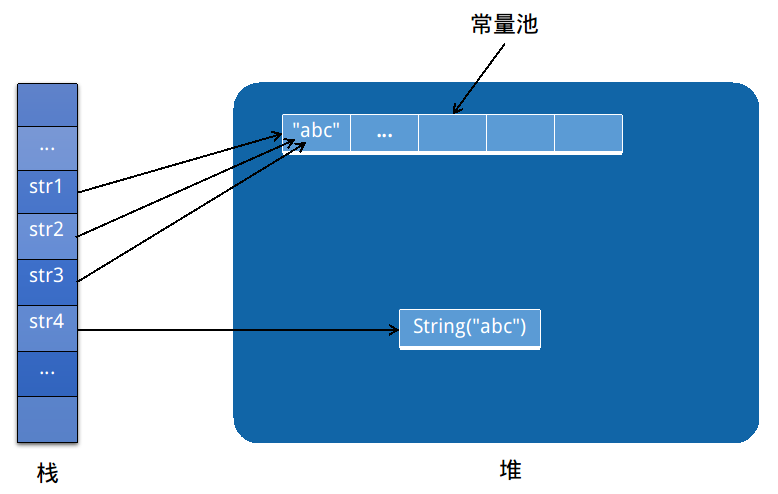1. String是使用char[]数组来存储的,并且String值在创建之后就不可以改变了。char[]数组的定义为:
/** The value is used for character storage. */
private final char value[];
char[]数组value使用final修饰,因此赋值之后就不可以改变了。再看一下String的hashCode()方法的实现就更能说明这一点:
/** Cache the hash code for the string */
private int hash; // Default to 0
成员变量hash,用来缓存String对象的hash code。为什么可以缓存?
因为String对象不可以改变,求hash code也不会变,因此有了缓存,不需要每次都求。代码如下:
/**
* Returns a hash code for this string. The hash code for a
* <code>String</code> object is computed as
* <blockquote><pre>
* s[0]*31^(n-1) + s[1]*31^(n-2) + ... + s[n-1]
* </pre></blockquote>
* using <code>int</code> arithmetic, where <code>s[i]</code> is the
* <i>i</i>th character of the string, <code>n</code> is the length of
* the string, and <code>^</code> indicates exponentiation.
* (The hash value of the empty string is zero.)
*
* @return a hash code value for this object.
*/
public int hashCode() {
// hash值为缓存值
int h = hash;
// 如果缓存的hash值为0,表示已经求过hash值,所以直接返回该值
// 如果是空字符串,那么hash值为0
if (h == 0 && value.length > 0) {
char val[] = value;
for (int i = 0; i < value.length; i++) {
h = 31 * h + val[i];
}
hash = h;
}
return h;
}
2. String的构造函数有多个,空串的构造函数为:
/**
* Initializes a newly created {@code String} object so that it represents
* an empty character sequence. Note that use of this constructor is
* unnecessary since Strings are immutable.
*/
public String() {
this.value = new char[0];
}
从代码可以看出,该构造方法生成一个空的char序列,就如注释所说“使用该构造方法是没有任何意义的”。
最常用的构造方法莫过于new String(String original):
/**
* Initializes a newly created {@code String} object so that it represents
* the same sequence of characters as the argument; in other words, the
* newly created string is a copy of the argument string. Unless an
* explicit copy of {@code original} is needed, use of this constructor is
* unnecessary since Strings are immutable.
*
* @param original
* A {@code String}
*/
public String(String original) {
this.value = original.value;
this.hash = original.hash;
}
该构造方法其实copy了original的value值和hash值,他们还是使用的同一串char序列。但是又创建了一个新的String对象,和original是不同的对象了。
3. 接下来通过一个例子来了解String是如何存储的。了解之前先回顾下java内存分配的几个术语:
栈:由JVM分配区域,用于保存线程执行的动作和数据引用。栈是一个运行的单位,Java中一个线程就会相应有一个线程栈与之对应。
堆:由JVM分配的,用于存储对象等数据的区域。
常量池:在编译的阶段,在堆中分配出来的一块存储区域,用于存储显式(不是通过new生成的)的String,float或者integer.例如String str="abc"; abc这个字符串是显式声明,所以存储在常量池。
例子:
String str1 = "abc";
String str2 = "abc";
String str3 = "ab" + "c";
String str4 = new String(str2);
//str1和str2引用自常量池里的同一个string对象
System.out.println(str1 == str2); // true
//str3通过编译优化,与str1引用自同一个对象
System.out.println(str1 == str3); // true
//str4因为是在堆中重新分配的另一个对象,所以它的引用与str1不同
System.out.println(str1 == str4); // false
- 第一个“str1 == str2”很好理解,因为在编译的时候,"abc"被存储在常量池中,str1和str2的引用都是指向常量池中的"abc"。所以str1和str2引用是相同的。
- 第二个“str1 == str3”是由于编译器做了优化,编译器会先把字符串拼接,再在常量池中查找这个字符串是否存在,如果存在,则让变量直接引用该字符串。所以str1和str3引用也是相同的。
- str4的对象不是显式赋值的,编译器会在堆中重新分配一个区域来存储它的对象数据。所以str1和str4的引用是不一样的。
图形化示例如下图所示:

3. 常用的equals()方法就比较朴实了,就是依次比较字符是否相同,
public boolean equals(Object anObject) {
if (this == anObject) {
return true;
}
if (anObject instanceof String) {
String anotherString = (String) anObject;
int n = value.length;
if (n == anotherString.value.length) {
char v1[] = value;
char v2[] = anotherString.value;
int i = 0;
while (n-- != 0) {
if (v1[i] != v2[i])
return false;
i++;
}
return true;
}
}
return false;
}
4. String实现了Comparable接口,自然有其compareTo()方法
public int compareTo(String anotherString) {
int len1 = value.length;
int len2 = anotherString.value.length;
// 获取两个String串的最小长度
int lim = Math.min(len1, len2);
char v1[] = value;
char v2[] = anotherString.value;
int k = 0;
// 依次比较两个String串最小长度范围内的相同位置的字符是否相同
// 如果不同,则返回Unicode编码的差值
while (k < lim) {
char c1 = v1[k];
char c2 = v2[k];
if (c1 != c2) {
return c1 - c2;
}
k++;
}
// 如果最小长度范围内的字符完全相同,则返回两个String串的长度之差
return len1 - len2;
}